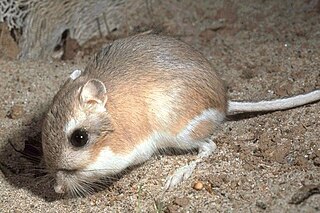
Kangaroo rats, small mostly nocturnal rodents of genus Dipodomys, are native to arid areas of western North America. The common name derives from their bipedal form. They hop in a manner similar to the much larger kangaroo, but developed this mode of locomotion independently, like several other clades of rodents.

The harvest mouse is a small rodent native to Europe and Asia. It is typically found in fields of cereal crops, such as wheat and oats, in reed beds and in other tall ground vegetation, such as long grass and hedgerows. It has reddish-brown fur with white underparts and a naked, highly prehensile tail, which it uses for climbing. It is the smallest European rodent; an adult may weigh as little as 4 grams (0.14 oz). It eats chiefly seeds and insects, but also nectar and fruit. Breeding nests are spherical constructions carefully woven from grass and attached to stems well above the ground.
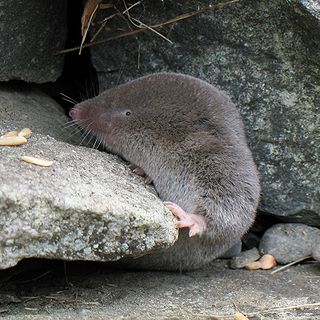
The northern short-tailed shrew is the largest shrew in the genus Blarina, and occurs in the northeastern region of North America. It is a semifossorial, highly active, and voracious insectivore and is present in a variety of habitats like broadleaved and pine forests among shrubs and hedges as well as grassy river banks. It is notable in that it is one of the few venomous mammals. The specific epithet, brevicauda, is a combination of the Latin brevis and cauda, meaning "short tail".

The smoky shrew is a medium-sized North American shrew found in eastern Canada and the northeastern United States and extends further south along the Appalachian Mountains.
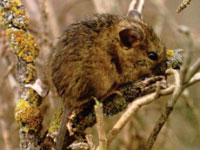
The salt-marsh harvest mouse, also known as the red-bellied harvest mouse, is an endangered rodent endemic to the San Francisco Bay Area salt marshes in California.
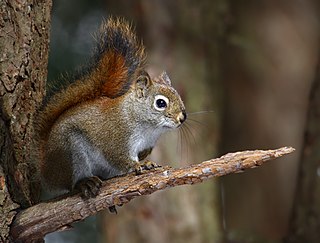
The American red squirrel is one of three species of tree squirrels currently classified in the genus Tamiasciurus, known as the pine squirrels. The American red squirrel is variously known as the pine squirrel or piney squirrel, North American red squirrel, chickaree, boomer, or simply red squirrel. The squirrel is a small, 200–250 g (7.1–8.8 oz), diurnal mammal that defends a year-round exclusive territory. It feeds primarily on the seeds of conifer cones, and is widely distributed across much of the United States and Canada wherever conifers are common, except in the southwestern United States, where it is replaced by the formerly conspecific southwestern red squirrel, and along the Pacific coast of the United States, where its cousin the Douglas squirrel is found instead.

The eastern woodrat, also known as the Florida woodrat or bush rat, is a pack rat native to the central and Eastern United States. It constructs large dens that may serve as nests for many generations and stores food in outlying caches for the winter. While widespread and not uncommon, it has declined or disappeared in several areas.

The western harvest mouse is a small neotomine mouse native to most of the western United States. Many authorities consider the endangered salt marsh harvest mouse to be a subspecies, but the two are now usually treated separately.
Nectomys squamipes, also known as the Atlantic Forest nectomys, South American water rat, or scaly-footed water rat, is a semiaquatic insectivorous rodent species. It is from Argentina, Brazil, and Paraguay — found primarily near forest rivers and streams in the Atlantic Forest ecoregion.
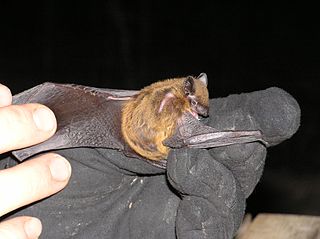
The evening bat is a species of bat in the vesper bat family that is native to North America. Hunting at night, they eat beetles, moths, and other flying insects.
The Texas mouse is a species of rodent in the family Cricetidae. It is found in Arkansas, Kansas, Missouri, Oklahoma, and Texas in the United States. This species is named in honor of Henry Philemon Attwater.

The California deermouse or California mouse is a species of rodent in the subfamily Neotominae in the family Cricetidae. It is the only species in the Peromyscus californicus species group. It is found in northwestern Mexico and central to southern California. It is the largest Peromyscus species in the United States.
The tawny deer mouse or marsh mouse is a species of rodent in the family Cricetidae. It is found only in Mexico.
The fulvous harvest mouse is a species of rodent in the family Cricetidae. It is found in El Salvador, Guatemala, Honduras, Mexico, Nicaragua, and the United States.
The slender harvest mouse is a species of rodent in the family Cricetidae. A small mouse-like rodent distributed throughout a portion Central America.
The plains harvest mouse is a species of rodent in the family Cricetidae. It is found in northern Mexico and the central United States.

The yellow-nosed cotton rat is a species of rodent in the family Cricetidae. It is native to Mexico and to the states of Arizona, New Mexico, and Texas in the United States, where it inhabits mountain grassland, scrub, and pinyon-juniper woodland. It is common over much of its wide range and the IUCN considers it to be of "least concern".

The spotted ground squirrel is a species of ground squirrel in the rodent family Sciuridae. It is found throughout Mexico and the central and western United States. Characterized by a white spotted back, the spotted ground squirrel is one of the smallest squirrels found in North America. They are mainly herbivorous, but also eat insects. A burrowing mammal, the spotted ground squirrel will make tunnels to store its food, as well as shelter and hibernation quarters.

The Sonoma chipmunk is a species of rodent in the squirrel family Sciuridae. It is endemic to northwestern California in the United States. Members of Neotamias are characterized by having 2 premolars. N. sonomae has 2 subspecies: N. s. alleni and N. s. sonomae.

The western jumping mouse, is a species of rodent in the family Zapodidae. It is found in Canada and the United States.















